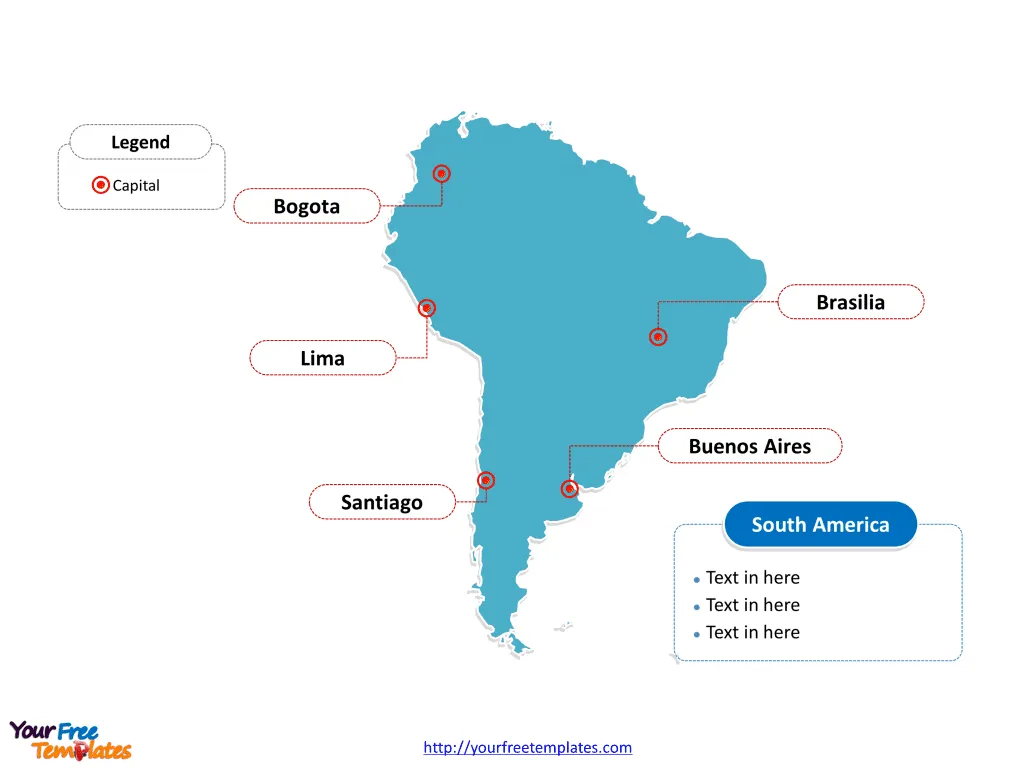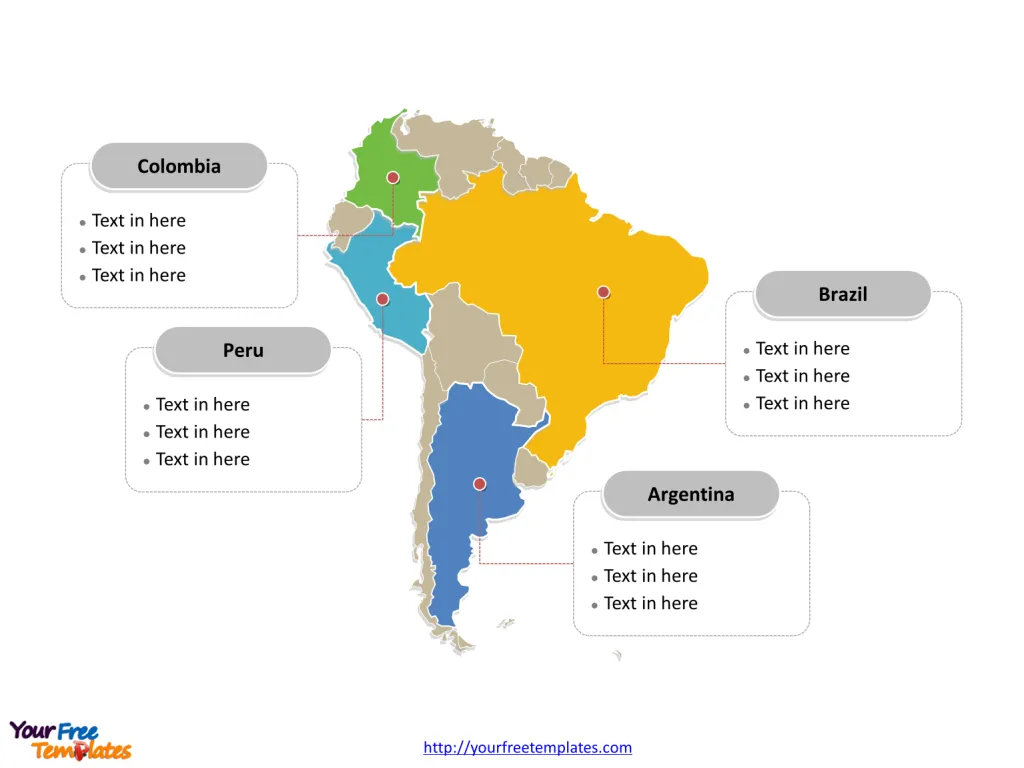The Map of South America Template in PowerPoint format includes two slides, that is, the South America map of outline and South America political map. Firstly, our South America outline map free templates have major cities on it. Secondly, there are 12 countries in our Blank South America map free templates, highlighting the most important countries.
South America, a continent rich in cultural diversity, natural beauty, and historical significance, is home to several major cities and countries that play pivotal roles not only regionally but also on the global stage. This exploration delves into the major cities of Bogotá, Brasília, Buenos Aires, Lima, and Santiago, along with an overview of the major countries of Argentina, Brazil, Colombia, and Peru.
Slide 1, South America Map labeling with capitals
Major Cities on our South America Map
Bogotá, Colombia
Bogotá, the capital and largest city of Colombia, sits high in the Andes at 2,640 meters above sea level. It’s a city where modern skyscrapers stand alongside colonial buildings, reflecting a blend of European and indigenous influences. Bogotá is the cultural, economic, and political heart of Colombia, famous for its historic Candelaria district, vibrant street art, and the Gold Museum, which houses the world’s largest collection of pre-Hispanic gold work.
Brasília, Brazil
Brasília, the capital of Brazil, is a city known for its modernist architecture and unique urban planning, conceived by the visionary architect Oscar Niemeyer and the urbanist Lúcio Costa. Inaugurated in 1960, Brasília was built with the idea of moving the capital from the coast to the interior, promoting national integration. The city’s layout resembles an airplane, symbolizing the country’s progress. It is a UNESCO World Heritage site, recognized for its artistic and architectural significance.

Buenos Aires, Argentina
Buenos Aires, the capital and largest city of Argentina, is often referred to as the “Paris of South America” due to its European atmosphere, grand boulevards, and vibrant cultural life. It is the birthplace of tango, which is much more than a dance in this city—it’s a cultural heritage. Buenos Aires boasts diverse neighborhoods, from the colorful La Boca to the upscale Recoleta, and is renowned for its steak, football passion, and lively arts scene.
Lima, Peru
Lima, the capital of Peru, is a city where the past and present coexist. Founded in 1535, Lima offers a rich history evident in its preserved colonial center, archaeological sites, and museums like the Larco Museum, which showcases pre-Columbian art. It’s also a culinary capital, offering an extraordinary fusion of indigenous, Spanish, African, and Asian cuisines. Lima’s dramatic coastline, vibrant markets, and lively nightlife add to its allure.
Santiago, Chile
Santiago, the capital and largest city of Chile, is nestled in a valley surrounded by the snow-capped Andes and the Chilean Coast Range. It’s a cosmopolitan city that serves as the cultural, political, and financial center of Chile. Santiago is known for its modern infrastructure, expansive urban parks like San Cristobal Hill, and landmarks including the La Moneda Palace. The city is a blend of old and new, with a growing arts scene, gastronomic innovations, and nearby vineyards.
Slide 2, Map of South America labeled with major Countries.
People know very well that the Map of South America is the country political division of there are 12 countries. To name them all, they are Argentina, Bolivia, Brazil, Chile, Colombia, Ecuador, Guyana, Paraguay, Peru, Suriname, Uruguay, and Venezuela. Also is a part of France (French Guiana), and a non-sovereign area (the Falkland Islands, a British Overseas Territory though this is disputed by Argentina).
In addition to this, the ABC islands of the Kingdom of the Netherlands, Trinidad and Tobago, and Panama may also be considered part of South America.
Major Countries highlighted in map of South America
Argentina
Argentina is a country of vast landscapes, from the subtropical north to the subantarctic regions of Patagonia in the south. It’s known for its rich cultural heritage, particularly in literature, music, and dance. Argentina’s economy is diverse, focusing on agriculture, manufacturing, and services. Buenos Aires, its capital, epitomizes the soul of the country with its eclectic architecture, fervent football culture, and the globally recognized tango.
Brazil
Brazil is the largest country in South America and the fifth largest in the world. It’s a land of great biodiversity, famous for the Amazon Rainforest. Brazil’s culture is a melting pot of indigenous, African, and Portuguese influences, reflected in its music, dance, and carnival celebrations. The economy is the largest in South America, with significant resources in agriculture, mining, and energy. Brasília, its capital, is a symbol of the country’s forward-looking spirit.

Colombia
Colombia is known for its coffee plantations, flower exports, and emeralds. It has a dynamic culture that reflects a mix of indigenous, African, and Spanish influences. Colombian music genres like cumbia and vallenato, along with the literary works of Gabriel García Márquez, have gained international recognition. Bogotá, its capital, is a hub for art and innovation.
Peru
Peru offers a tapestry of ancient cultures, from the Inca Empire to pre-Columbian civilizations. It’s a country with diverse ecosystems, from the Amazon basin to the Andes mountains. Peru’s rich cultural heritage is evident in its archaeological sites, such as Machu Picchu, and its cuisine, which has gained international acclaim. Lima, the capital, is the heart of the nation’s cultural and culinary renaissance.
Conclusion
South America’s major cities and countries reflect a blend of indigenous, European, African, and Asian influences, creating a rich cultural tapestry. From the architectural wonders of Brasília to the culinary delights of Lima, the continent offers a wealth of experiences. Argentina, Brazil, Colombia, and Peru, with their diverse landscapes and vibrant cultures, are central to understanding South America’s allure and significance on the world stage.
At the same time you can also refer to the fully labeled Map of South America in Wikipedia.
Size: 97K
Type: PPTX
Aspect Ratio: Standard 4:3
Click the blue button to download it.
Download the 4:3 Template
Aspect Ratio: Widescreen 16:9
Click the green button to download it.
Download the 16:9 Template











